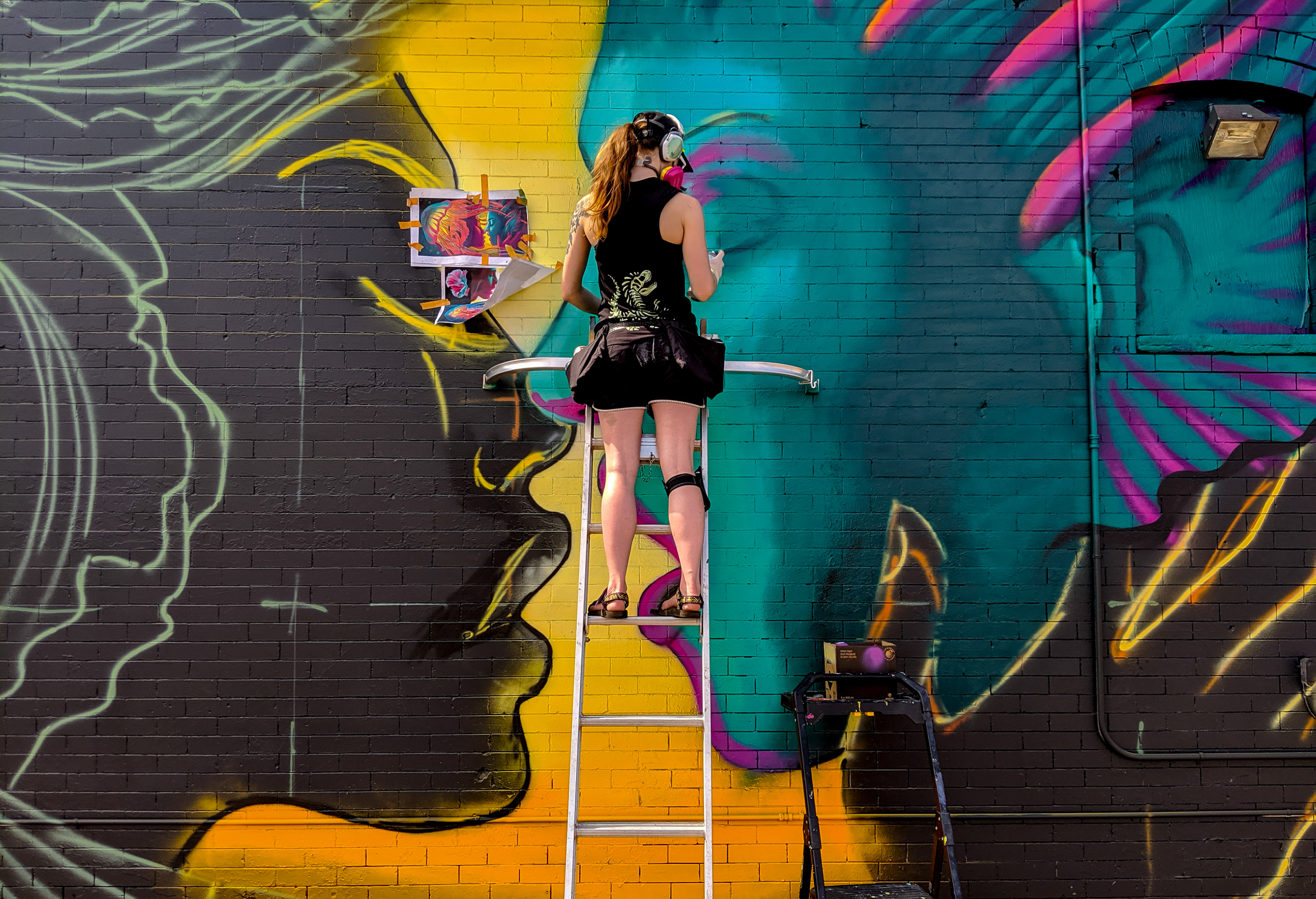Part of the wonder and joy of RiNo’s annual street art festival CRUSH WALLS is witnessing the making of the murals and graffiti that cover the alleys and walls of the neighborhood. Unless you had time to hit the streets every day this week, there’s a chance you missed this interesting progression. So we took photos of some of the murals throughout the week, just to illustrate how each artist uses different processes and workflows in order to get their wall done.
Aerose Art and The Designosaur
Both The Designosaur and Aerose Art (Julia Rose Morgan) use spray paint to create their powerful mural art with flowing colors and realistic faces. In the first photo, you can see the design sketch taped to the wall next to The Designosaur — an easy way for her to keep an eye on where things should be painted without having to step off the ladder and stand back. The second photo shows the outlines that were sketched with spray paint before color-blocking (or basically coloring in) started happening. You can see how the dimension and depth come alive with colors by the third photo.
Armando Silva
Armando Silva — a Greeley-based street artist — started with the center of his mural and worked out from there. He specializes in portraits, and this one depicts the Mexican TV character “El Chavo del Ocho” written and performed by Roberto Gomez Bolaños or “Chesperito.” Once Silva had the face drawn to his liking (using spray paint) he filled in the colors around it.
The Worst Crew
Denver-based artists Jaime Molina and Pedro Barrios work together as a team on a regular basis, so their process is nearly down to a science. First, they chalk the outline (some portions of this massive mural had to be chalked using a long stick with a piece of chalk attached to the end). Then, they start filling in pieces with a primer or background paint color. Molina is known for the face you can see in the final photos above, which he creates with a paintbrush. Barrios works on the surrounding ornamentation and pattern-work.
Marka27
Visiting artist Marka27 shows just how impressive the world of “freehanded” street art can be with this monumental piece. “Freehanded” refers to spray-painted designs that use no other tools — like projectors, tape, stencils — aside from a can of spray paint. The sketch, the coloring and the finished touches all come from a can, and from the practiced hand of an artist like Marka27.
Michael Ortiz aka Illson
Michael Ortiz is a well-known figure in the Colorado street art scene, with murals in nearly every district in Denver. This mural is a difficult one to complete for any artist, as it’s on a corrugated metal wall. Each ridge of the corrugation causes difficulties for straight lines or sharp edges. But, Ortiz is experienced. Rather than fighting the wall, he used the ridges as part of his design by painting them as accent stripes. In the photos above, you can see how Ortiz starts with the middle of the mural but then works his way out in a non-linear fashion.
Patrick Kane McGregor and Adrian Avila
This towering piece at Industry RiNo Station is a collaboration between Denver-based Patrick Kane McGregor and Adrian Avila — an artist McGregor met in Miami a few years ago. Avila spent the first portion of the week perfecting the woman’s arm and face near the top of the wall and then spent the weekend gold-leafing her hair. McGregor sketched out his iconic bulldog at the bottom and then started painting it in — a transformation that is readily apparent in the last two photos of the slideshow.
Alexandrea Pangburn and R0melle
Denver-based artists Alexandrea Pangburn and R0melle worked together on this neon-backed bird on Larimer Street. Using a squiggle grid (or squiggle overlay), the two were able to paint different parts of the mural at the same time. A squiggle grid is when a muralist writes letters, numbers and symbols on the wall, takes a photo of the wall, overlays their design onto the photo and then uses that as a point of reference. The bend of the neck might intersect a certain letter, which allows the artists to paint a foot away from the wall and not lose perspective. R0melle and Pangburn used spray paint for this entire piece.
Tribal Murals
This was the first year that Tribal Murals participated in CRUSH. The process she used was traditional — first chalking the entire outline and then filling in with color and finishing with small details.






Can we post this mural artice for our audience on LatinLifeDenver.com. Giving full credit to 303 Magazine and the photographer.
Hey Joe! You can post an excerpt from the article (not the full article) that links back to 303 for people to read the rest. Make sure to credit 303 and the author and photogs and please email us a link when it’s live: Brittany@303magazine.com
Are there any maps to be able to visit any of these murals if they are still visible?